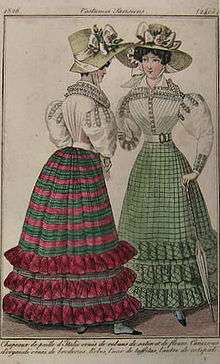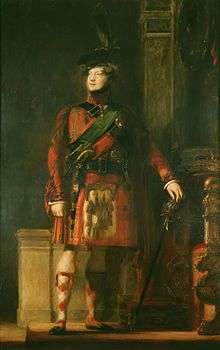Tartanry

Tartanry is the kitsch elements of Scottish culture that have been over-emphasised or super-imposed on the country, first by the emergent Scottish tourist industry in the 18th and 19th centuries, and later by an American film industry. The earliest use of the word "tartanry" itself is said to have been in 1976.[1]
Definition
Tartanry is the reduction of Scottish culture to kitsch, twee, inaccurate imagery based on ethnic stereotypes. Often the image presented is that of the Highlander as noble savage. While there are strong, legitimate cultural traditions behind Scottish clan societies and the older tartans, kilts, and bagpipes, Tartanry is when these things are tokenized, distorted, misrepresented as ancient in instances where they are not, or attached to fabricated histories. While Scottish Gaelic is a living language, that has developed and grown with modern culture, Tartanry presents it as a dead relic and curiosity, and those acting from this perspective may simply redefine words, or change their spellings to gibberish, for no other reason than to appear quaint or exotic.
History

Modern historians suggest that due to economic and social change, the clan system in the Highlands was already declining by the time of the failed 1745 rising.[2] In its aftermath the British government enacted a series of laws that attempted to speed the process, including a ban on the bearing of arms, the wearing of tartan (in the Dress Act 1746) and limitations on the activities of the Episcopalian Church. Most of the legislation was repealed by the end of the eighteenth century as the Jacobite threat subsided. There was soon a process of the rehabilitation of Highland culture. The Dress Act was repealed in 1782, and tartan was adopted for Highland regiments in the British army, which poor Highlanders joined in large numbers until the end of the Napoleonic Wars in 1815. However by the nineteenth century tartan had largely been abandoned by the ordinary people.[3]
In the 1820s, as part of the Romantic revival, tartan and the kilt were adopted by members of the social elite, not just in Scotland, but across Europe.[3][4] The international craze for tartan, and for idealising a romanticised Highlands, was set off by the Ossian cycle published by Scottish poet James Macpherson's in 1761-2.[5][6] Sir Walter Scott's Waverley novels further helped popularise select aspects of Scottish life and history and he founded the Celtic Society of Edinburgh in 1820.[7] He staged the royal Visit of King George IV to Scotland in 1822 and the king's wearing of tartan. George IV was the first reigning monarch to visit Scotland in 171 years.[7] Scott and the Celtic Society urged Scots to attend festivities "all plaided and plumed in their tartan array".[8] One contemporary writer sarcastically described the pomp that surrounded the celebrations as "Sir Walter's Celtified Pagentry".[9][10] Nevertheless, the result was a massive upsurge in demand for kilts and tartans that could not be met by the Scottish linen industry.[11]
Lord Macaulay, son of an Argyll family, wrote of the Romantic reinvention of Highland customs:
| “ | Soon the vulgar imagination was so completely occupied by plaids, targets, and claymores, that, by most Englishmen, Scotchman and Highlander were regarded as synonymous words. Few people seemed to be aware that, at no remote period, a Macdonald or a Macgregor in his tartan was to a citizen of Edinburgh or Glasgow what an Indian hunter in his war paint is to an inhabitant of Philadelphia or Boston. Artists and actors represented Bruce and Douglas in striped petticoats. They might as well have represented Washington brandishing a tomahawk, and girt with a string of scalps.[12] | ” |
The designation of individual clan tartans was largely defined in this period and they became a major symbol of Scottish identity.[11] The fashion for all things Scottish was maintained by Queen Victoria who helped secure the identity of Scotland as a tourist resort and the popularity of the tartan fashion. Her Highland enthusiasm led to the design of two new tartan patterns, “Victoria” and “Balmoral”, the latter named after her castle Balmoral in Aberdeen, which from 1852 became a major royal residence.[4]
See also
- Brigadoon
- Plastic Paddy
- Scottish national identity
- Visit of King George IV to Scotland
- White Heather Club
References
- ↑ Sunday Times (Colour Suppl.) 31 Oct 73 Tartanry has spread into radio, television, cabaret and clubs
- ↑ R. C. Ray, Highland Heritage: Scottish Americans in the American South (UNC Press Books, 2001), ISBN 0-8078-4913-8, p. 41.
- 1 2 J. L. Roberts, The Jacobite Wars: Scotland and the Military Campaigns of 1715 and 1745 (Edinburgh: Edinburgh University Press, 2002), ISBN 1-902930-29-0, pp. 193-5.
- 1 2 M. Sievers, The Highland Myth as an Invented Tradition of 18th and 19th Century and Its Significance for the Image of Scotland (GRIN Verlag, 2007), ISBN 3-638-81651-6, pp. 22-5.
- ↑ P. Morère, Scotland and France in the Enlightenment (Bucknell University Press, 2004), ISBN 0-8387-5526-7, pp. 75-6.
- ↑ William Ferguson, The identity of the Scottish Nation: an Historic Quest (Edinburgh: Edinburgh University Press, 1998), ISBN 0-7486-1071-5, p. 227.
- 1 2 I. Moncreiffe of that Ilk, The Highland Clans (London: Barrie & Rocklif, 1967), pp. p. 24.
- ↑ M. Magnusson, Scotland: The Story of a Nation (Grove Press, 2003), ISBN 0-8021-3932-9, pp. 653-4.
- ↑ I. Moncreiffe of that Ilk, The Highland Clans (London: Barrie & Rocklif, 1967), pp. 653-4.
- ↑ I. Duncan, Scott's Shadow: The Novel in Romantic Edinburgh (Princeton University Press, 2007), ISBN 0-691-04383-3, pp. 7–8.
- 1 2 N. C. Milne, Scottish Culture and Traditions (Paragon Publishing, 2010), ISBN 1-899820-79-5, p. 138.
- ↑ The History Of England From the Accession of James II: Chapter XIII (under “The State of the Highlands”) – Thomas Babington Macaulay
| ||||||||||||||||||